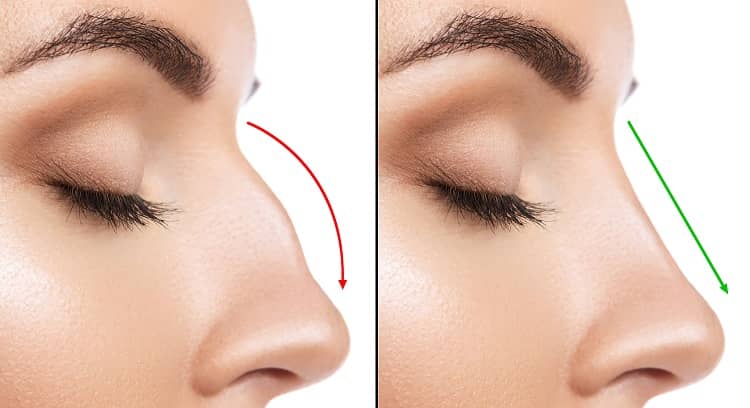Rhinoplasty is a type of surgery that is done to reshape the nose and enhance facial harmony. It can also be used to correct structural defects, including those that trigger breathing problems. Rhinoplasty is not a procedure with specific steps, it is customized specifically according to the goals of the patient undergoing the surgery. The various changes associated with a rhinoplasty surgery are-
- Nose width at the bridge and position of the nostrils.
- Change in nose size with respect to the facial balance.
- Change in the angle of the nose with respect to the upper lip.
- Correcting defects like bumps, indentations etc.
- Alteration in the tip of the nose, especially in the nasal tip that is hooked, upturned, drooping, bulbous or enlarged.
- Large, wide or upturned nostrils.
- Nasal asymmetry
You are a good candidate for this surgery if-
- You have realistic goals for the improvement of your appearance.
- You don’t smoke.
- You are healthy and fit.
- Your facial growth is complete.
Procedure of Rhinoplasty
- A local or general anesthesia is given to the patient so that he/she does not feel uncomfortable during the surgery.
- Tiny incisions are made inside the nostril to access the underlying bone and cartilage.
- According to the type of result expected by the patient, some tissues from another part of the body might also be added to the nose using synthetic fillers. Sometimes bones and cartilage are also removed to give the nose a proper shape.
- After the rearranging and reshaping of the bone, tissue and nasal skin is redraped and incisions are sealed.
- Lastly, a splint is placed outside the nose to provide support to the new nose shape. In some cases, the doctor may also use pieces of nasal packing or gauze inside the nostrils to keep the septum in place and reduce bleeding.
- Generally, a 1-night stay at the hospital is needed after the surgery.
Rhinoplasty with other surgeries
As the nose plays an important role in the facial structure, many patients usually opt for other treatments along with rhinoplasty. These can include chin reduction, chin augmentation, facelift, cheek augmentation and brow lift.
Recovery and Care
Rhinoplasty can involve several weeks of recovery but you can return to work within two weeks of surgery. Swelling may subside within a few weeks, but it may take up to a year for your nasal contour to fully refine. Your doctor will provide specific instruction on how to care for the surgical site. It is very important to stay on proper medications after the surgery to help reduce the pain.
- It is advised not to use reading glasses or sunglasses for the first month after the surgery to enable correct nasal healing.
- Wear sunscreen with an SPF of 30 or more whenever you go outside.
- Avoid strenuous exercise.
- You will be advised to keep your head elevated for the first few days.
- Try to keep your face still as much as possible.
- Eat foods containing lots of fiber and nutrients.
- Apply cold compresses to the mid-face and nose.
- Brush your teeth gently to avoid putting any kinds of pressure on the nose and upper lip.
- Avoid wearing clothes that go on over the head. Instead, wear clothes with
How long do the results last?
The results, either significant or minor, will be or life long. Although the surgery is done to reshape the nose, the overall result will be within the limit. The surgery will be performed within the framework of your face and exceptionally high results must not be expected. A healthy lifestyle will help extend the results of your new look.
Risks associated with the surgery
As with any major surgery, rhinoplasty also carries risks and complications. These are-
- Temporary swelling and bruising.
- Bleeding.
- Injury or hole in your septum.
- Skin irritation because of tape and bandaging.
- Nasal blockage due to the swelling.
- Adverse reaction to anesthesia.
- Infection.
- Feeling of numbness around the nose.
- Scarring.
- Possibility of an uneven-looking nose.
You can avoid many risks and complications by choosing a surgeon who has adequate experience in plastic surgery. Be sure to ask questions and discuss your surgical goals, with regard to both breathing and appearance.
Blog written by:
Dr. Sasikumar
Consultant Cosmetic Surgery
Apollo Cosmetic Clinics, MRC Nagar

